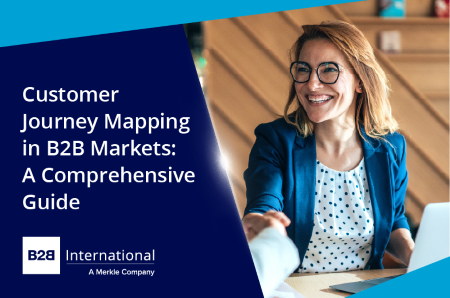
The importance of customer journey mapping
Whilst logic might tell us that happy and engaged customers should be a top priority for b2b brands, our research tells us that only 2 in 10 companies would consider themselves ‘CX Leaders’ – namely, those fully committed to delivering on customer needs and providing a seamless experience for their customers.
The core foundation to managing the experience of your customers, is to understand what your customer journey looks like end-to-end, so you can better establish what is working and where any challenges, pain points or roadblocks lie that might make life more difficult for your customers. For example, a customer’s initial interaction with our brand might be our website, but if this isn’t intuitive, clear, or easy to navigate, this can be a pain point. Similarly, we might have a seamless sales process when onboarding clients to our product or service offering, but we can erode the customer loyalty we have built if our aftersales is problematic and if it’s not easy for customers to resolve a business or time-critical issue they are facing.
Customer journey mapping is an important first step in creating a more deliberate, seamless, end-to-end customer experience. As implied, it involves mapping out all the individual touchpoints or interactions our customers have with us. In this blog, we’ll share our top tips for conducting an effective customer journey mapping workshop, as part of a wider customer journey research program.
Our 5 top tips for running an effective customer journey mapping workshop
-
Go all in – run the session in person
Without customers, we have no reason to exist. They are an organization’s most important asset and yet if you were to ask most organizations to describe the end-to-end journey their customers take, most would return a blank face!
Whilst it’s become more commonplace to run online meetings, we would always recommend running a journey mapping workshop in person. More than anything, you will give this exercise the undivided attention it deserves. The “light bulb” moments and transferable learnings that can be experienced on the day by having multiple internal stakeholders in the same room discussing the customer journey is unparalleled.
-
Get the right people in the room
The point of customer journey mapping is to allow internal stakeholders to put themselves in their customer’s shoes and think about all the interactions they have. Ultimately, every interaction that a customer has contributes to their perception of that brand. When doing this, it’s helpful to think about the five senses – what customers see, hear, touch, taste or smell. In other words, from the customer’s point of view, if they can see it, smell it, touch it, taste it, hear it, feel it, sense it, click it, hold it, carry it, use it, step on it, or step over it….it becomes a part of the customer experience and therefore the brand. Put another way, if there are interactions that take place in your organization that customers don’t see, these don’t count as part of the customer journey and are part of an internal process.
When creating a journey map, we might be focusing on a specific section of the journey or exploring the full customer journey end-to-end. A full journey map might start with how customers become aware of our brand through to making an enquiry, service delivery, aftersales and even what happens at the point at which they leave us or return as a returning customer. To ensure the workshop captures all these different interactions, it’s important to include a range of internal stakeholders and departments in the room; those that can input into different stages of the journey. For example, someone from Marketing that can input into how customers become aware of our brand, the Sales team for the sales process, the Project Delivery team, the Finance team and so on. Typically, you would aim for 10-20 maximum stakeholders at the workshop.
-
Prepare!
As with any planned exercise, you get out of this what you put in, so you don’t want to wing it, especially if you’ve gone to the trouble of getting the right people in the room. When preparing for a workshop, it’s important to decide on which parts of the journey you wish to explore, who will attend and then tailor the exercises on the day accordingly.
Before each workshop, we usually discuss options with our clients and then prepare the customer journey “spine”. The spine consists of overarching touchpoints or key stages in the journey where the main journey mapping exercise consists of asking stakeholders to think about all the specific interactions that might take place within each touchpoint.
As an example, our end-to-end journey “spine” might include the following overarching touchpoints:

If we take ‘Awareness’ as the first overarching touchpoint, examples of the individual interactions or touchpoints mapped out in the exercise might include things like word-of-mouth recommendations, the website, direct mail, seeing the brand logo on a delivery van, online searches, social media etc. These are all interactions our customers might experience when becoming aware of our brand. Taking this approach, you can see how a journey mapping exercise could easily identify a hundred or so different interactions that our customers experience with us!
More than this, as is true for many b2b organizations, there might be a range of different customer types we are serving and therefore variation in the touchpoints and interactions that take place. It’s therefore crucial to think carefully about who will attend the session, the time available and what we already know or don’t know, in order to make the most out of the workshop.
-
Allow the time needed to run multiple exercises over a day
Tied to the previous point, a detailed journey mapping can take some time and so we’d recommend, where possible, a full working day’s workshop dedicated to this. First and foremost, is the mapping of touchpoints as we’ve described already, but there are additional exercises you could run to get the most value from the day. We include some popular examples below:
-
Heat-mapping performance: Using colored pens or stickers, get all stakeholders to mark individual touchpoints as those which are “pain points” for customers now or those which are “moments of delight”. If time allows, we can also mark up the touchpoints which we see as the “moments of truth” i.e. those touchpoints which are the most important to customers and carry the most power to build or destroy loyalty over time.
-
Exploring emotions/sentiment: At each stage of the journey, we can also ask stakeholders to think about they key emotions they feel customers experience now (whether positive, negative, neutral or a combination) alongside the emotions we would ideally like them to feel.
-
Assigning departmental responsibility: Once all touchpoints have been mapped, it can be useful to review all of those identified and think about which department (or departments) have responsibility for delivering that touchpoint.
-
Brainstorming improvement areas: Given all the valuable learnings and discussion on the day, it can be useful to home in on the momentum that’s been built and capture some key learnings and immediate improvement areas or action points to consider.
-
-
Consolidate learnings to cascade
As is clear, there is a considerable amount of insight that can be captured during a journey mapping workshop. When preparing the outputs, we often find that there are the more detailed outputs and then something more high-level and visual that can be useful to cascade more widely. Whilst we have an in-house design team who can custom-create journey maps in our client’s own branding, another option is to hire a visual scribe to attend the session and capture a visual representation of what’s discussed in-the-moment.
Whatever you decide, think about how to cascade the findings – it’s valuable for everyone within an organization to be clear on the customer journey, since directly or indirectly, we all play a part in delivering the customer experience, no matter what department we sit in!
To discuss how our tailored insights programs can help solve your specific business challenges, get in touch and one of the team will be happy to help.




